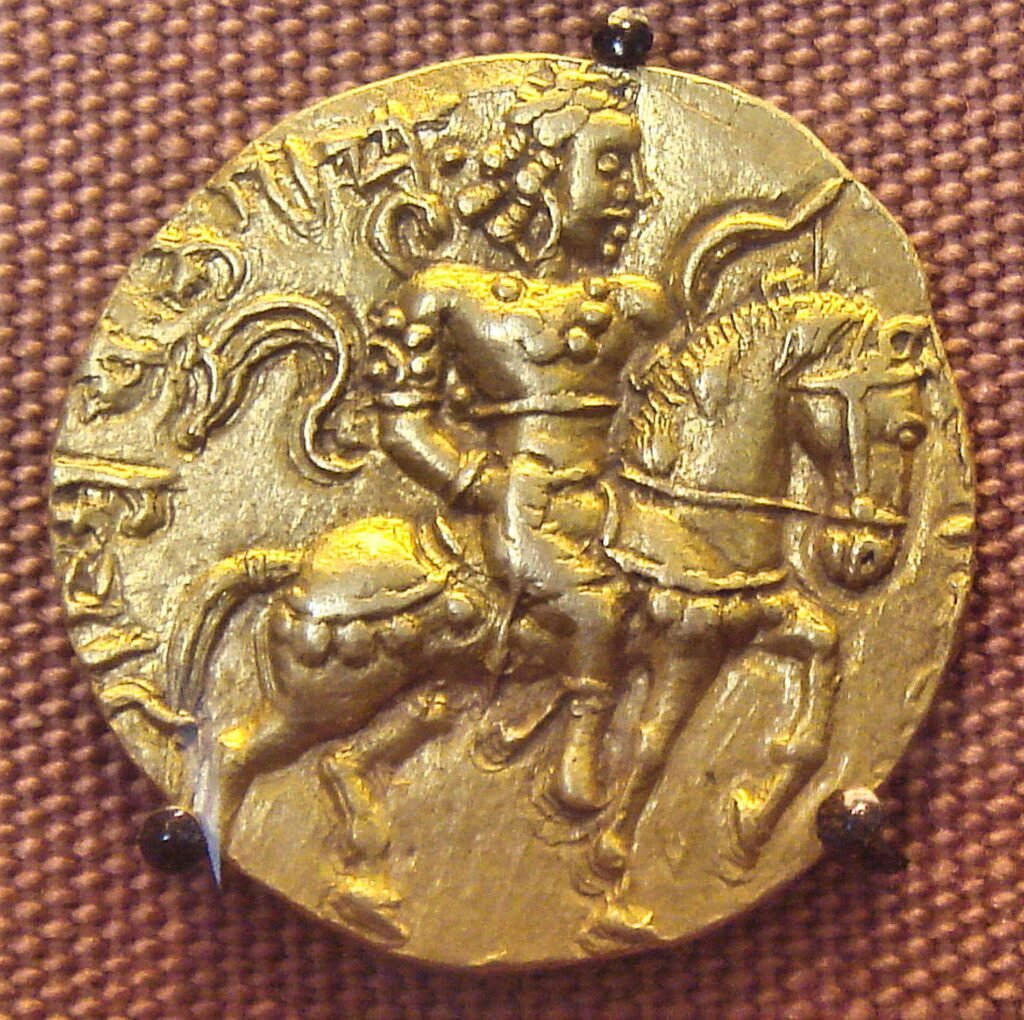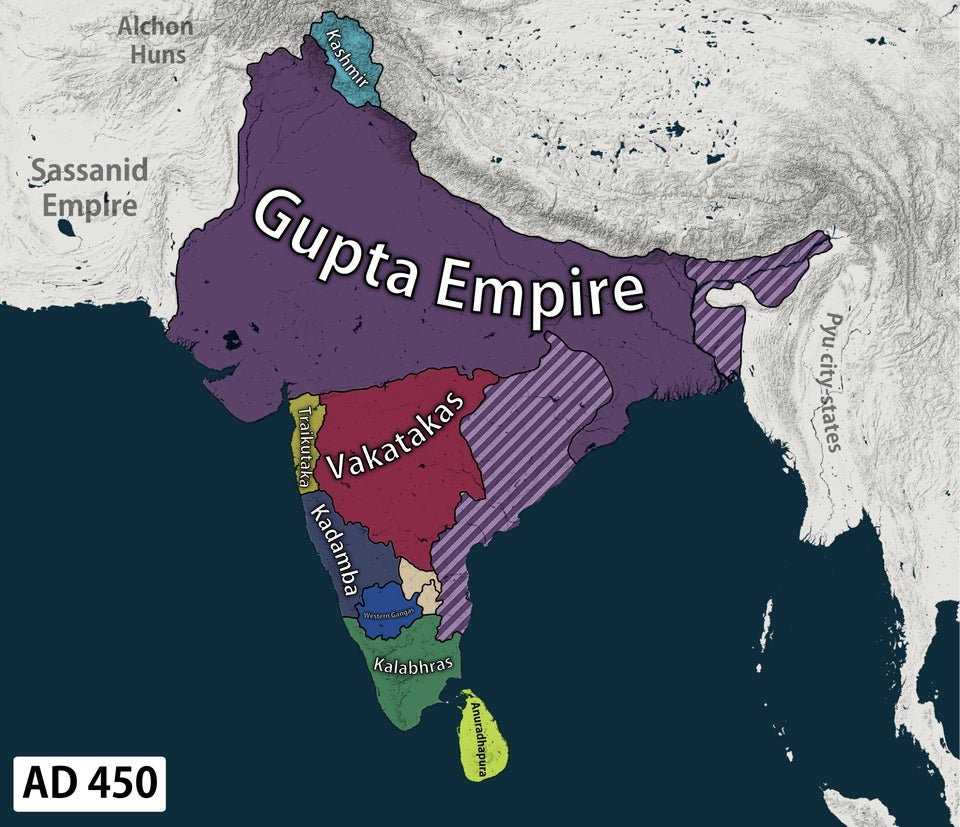The Vakatakas, often overlooked in popular ancient Indian stories, were a potent
dynasty that ruled for nearly three centuries and had strong connections with the
Guptas.
Origin of Guptas
Historians have been speculating about the Gupta dynasty’s exact origins because it is still unknown. While some contend that Magadha was the ancestral homeland, others assert that North Bengal was. Nonetheless, a consensus among academics indicates that eastern Uttar Pradesh was the original location of the Gupta domain.
According to Romila Thapar, the Gupta family was originally from a wealthy landowning class and gradually spread their influence to areas such as Magadh. While Dr. K.P. Jaiswal recognizes them as Jatts from the Punjab region, Dr. Altekar categorizes them as a Vaishya family. While Dr. S. Chatopadhyaya classifies them as Kshatriyas, Dr. H.C. Ray Choudhary links them to a Brahman family of the Dharni gotra.
Sources to reconstruct the story of the Guptas
The Gupta dynasty’s history is reconstructed by historians using a range of sources, such as literary and archaeological data. Literary sources include Smritis like the Narad Smriti and Brihaspati Smriti, as well as Puranas like the Vayu Purana and Matsya Purana. Dramatic pieces like “Mṛicchakatika” by Shudraka, “Mudrarakshasa” by Vishakhadatta, “Abhigyan Shakuntalam” by Kalidasa, and “Kavya Mimansa” by Rajasekhar also offer insightful perspectives. Important Jain texts such as the “Kuvalayamala” and Buddhist texts also provide insight into the Gupta period.
Fa-Hien’s historical account is especially important because it provides insightful details on the social, political, and economic developments that occurred during that period.
Inscriptions such as the “Prayaga Prashasti,” the Bhitari inscription, and the Mandsor inscription can be found in archeological sources. The study of coins, particularly those made of gold and silver, is important, and archaeological digs add new perspectives to our knowledge. Paintings, sculptures, and temples all add to the thorough reconstruction of the Gupta era.
Rulers of Gupta Period
From roughly 320 to 550 CE, the Gupta Empire flourished in ancient India. For over a century, the Gupta dynasty maintained political unity in northern India. Because of the advancements made in science, math, literature, and the arts, this period in Indian history is regarded as unique.
Chandragupta The Gupta dynasty began during his reign, and I established the Gupta Empire. Samudragupta, his son, won battles and grew the empire.
Chandragupta II, also known as Chandragupta Vikramaditya, was a well-known Gupta emperor.
He is renowned for encouraging academics and artists and is frequently regarded as the greatest Gupta emperor. The Gupta Empire expanded under his leadership and made significant cultural advancements.
The Gupta emperors were also fond of Hinduism and favored the Brahmanical lineage. They depicted Hindu gods and goddesses on gold coins, expressing their religious convictions.
Chandragupta I, who was also referred to as Chandragupta Maurya, was the inaugural ruler of the Mauryan Empire in historical India. From 322 to 298 BCE, he was king. Chandragupta I was born into a modest family in Magadha, but his military prowess and political acumen helped him rise to prominence as a leader.
Chandragupta By subduing other empires and annexing their territories, I grew the Mauryan Empire. He subjugated regions such as Afghanistan, Punjab, and portions of Central Asia. His empire was well-run, with a robust administrative structure to oversee the numerous territories it ruled.
Chandragupta By the terms of the Treaty of Seleucus, I also became friendly with the Greek Seleucid Empire. This friendship made it possible for Greece and India to share their cultures while also maintaining regional peace.
Samudragupta
Samudragupta was a strong leader, and the Prayag Prasasti (written by Harishena) is the primary source of information about him. He was commended in the Allahabad Prashasti and was well-known for taking aggressive measures to grow his empire. Indra and Varuna were compared to him in terms of greatness, and he was given the name “Dharni Banddh.”
V.A. Smith compared him to Napoleon of India because of his military successes. He fought in campaigns in the Indian subcontinent, then known as Aryavarta.
Many local rulers were faced and defeated by him during these campaigns. The name “Aryavarta” is derived from the prehistoric term for the Indian subcontinent; the Gupta Empire incorporated the victories of Samurdragupta.
Additionally, Samudragupta invaded the South and overthrew twelve kings. Instead of capturing or annexing their lands, he pardoned them. This method is referred to as “Graham and Moksha.” He overthrew the leaders of border kingdoms like Samtat, Kamrupa, and Nepal, as well as those in the forest state, to increase his power.
In addition to his conquests in India, Samudragupta defeated foreign rulers like the
Kushanas, Shakas, and even those from Sri Lanka. His reign was marked by military
achievements and the expansion of the Gupta Empire.
Ramagupta
Gupta inscriptions state that Chandra Gupta II was Samudra Gupta’s successor. However, Ramgupta—who is purported to be Samudra Gupta’s elder son—is mentioned in literary works such as Vishakhadatta’s drama “Devi Chandragupta.” According to the drama, Ramgupta was killed by Chandra Gupta II.
In “Devi Chandragupta,” Ramgupta loses to the Shakas as the story progresses. Ramgupta attempts to negotiate the surrender of his wife, Druhdevi, in a last-ditch effort to preserve his kingdom. But because of this shameful deed, Chandra Gupta II killed Ramgupta and took the throne as the new monarch.
Chandragupta II

During his reign from 380 to 415 CE, Chandragupta II, also called Chandragupta Vikramaditya, played a crucial role as the ruler of the Gupta Empire in ancient India. He is frequently cited as the greatest Gupta emperor. He was the grandson of Chandragupta I and the son of Samudragupta.
The inscription found on the Mehrauli Iron Pillar is a crucial archaeological document that showcases the accomplishments of Chandragupta II. It shows his territorial expansion beyond Sindhu, his victorious vanga (West Bengal) defeat, and his diplomatic relations with the Vakatakas and Nagas.
Through military campaigns, Chandragupta II expanded the Gupta Empire by eliminating the Saka Satraps in Gujarat, the Saka Western Kshatrapas, and securing the Malwa region.
These triumphs brought riches and resources to the empire in addition to its expansion.
Known for his encouragement of the arts, sciences, and literature, Chandragupta II’s reign is referred to as the “Golden Age of India.” In his court, scholars such as Kalidasa, Varahamihira, and Aryabhata thrived, leading to a period of intellectual and cultural advancements.
Considered the apex of ancient Indian history, Chandragupta II’s reign was characterized by administrative advancements, military prowess, and the promotion of cultural growth.
He was succeeded as the Gupta Empire’s ruler by Kumar Gupta.
Kumar Gupta
We gather information about him from various sources, including the Bilsad inscription,
Karamdanda inscription, Mandsor inscription, and Damodar copper plate inscription.
During this time, the establishment of Nalanda University was noteworthy, indicating
his interest and support for education.
Skandagupta
The Junagarh inscription offers insights into an important event, the Huna invasion, and is associated with Skandagupta. The Bhitari inscription contains information regarding the Huna invasion.
Why Decline of the Gupta Empire
The Gupta Empire collapsed for a number of reasons. One major issue was the difficulty in selecting new rulers following the demise of influential monarchs like Chandragupta I and Samudragupta. Due to conflicts over who should be in charge and weaker rulers, the empire broke up into smaller regions.
- The administration grew weaker as the Samantyas, or local rulers, gained power and exercised independent rule. They were required to support the king in both military and economic affairs, but they were also uncontrollable.
- The Huna, also known as the White Huns, were a Central Asian tribe that the Gupta Empire struggled to control. The Gupta Empire was heavily pressured by these invasions, which made it less robust militarily and economically.
- Another issue was economic ones. The Gupta Empire’s over-reliance on land revenue resulted in a decline in total tax revenue. Invasion-related disruptions to the trade routes reduced commerce and business.
- The decline also included shifts in culture and society. Social tensions were brought on by the tightening of the caste system. Strong regional powers grew in strength as well, undermining the Gupta Empire’s central government.
- In general, the Gupta Empire struggled to maintain control over its vast domain, and local leaders became increasingly influential. The empire finally fell apart as a result of this.
Vakatakas
The Vakatakas were a powerful dynasty that ruled for almost three centuries and had close ties to the Guptas. They are frequently left out of popular accounts of ancient Indian history.
The main sources of information about the Vakataka dynasty’s chronology and rulers are Puranas and inscriptions like the Ridhpur and Poona copper plate inscriptions. Inscriptions on seals are another source of information.
One Vindhya Shakti, a Brahmin, founded the Vakataka Empire. Pravarasena I, who attained the status of Samrat and performed four Ashwamegh sacrifices to demonstrate his power, was the true expansionist.
In the fourth century AD, after Pravarasena, the empire divided into the Vatsagulma branch in the Akola district and the Nandivardhana branch in Nagpur. With the Guptas, the Nandivardhana branch forged matrimonial alliances, and Prabhavati Gupta rose to prominence following her husband’s passing. She kept up cordial ties with the Vakatakas.
The Vakatakas made significant contributions in various areas
- The revival of Brahmanism was greatly aided by them, as they emphasized and supported the customs and practices of the Brahminical community.
- Shaivism’s renaissance was furthered by the Vakatakas, who promoted Lord Shiva’s worship and spread of the religion.
- Welfare State : Their state was described as a welfare state because of its dedication to the welfare of its people.
- Charitable Contributions : The Vakatakas were renowned for their abundant donations, kindly aiding temples and Brahmins, consequently advancing spiritual and artistic pursuits.
- Economic Prosperity : Growth and development in a number of sectors were encouraged by the economic prosperity that characterized their rule.
- Language Development : They contributed to the literary and cultural legacy of the area and helped shape the development of several languages, including Sanskrit and Prakrit.
Pre & Mains : Buy History NCERT 11th class by R.S.Sharma for UPSC
History Optional : Buy A History of Ancient And Early Medieval India : From the Stone Age to the 12th Century By Upinder Singh
Featured image credit :- wikimedia license
Inline image credit :- World History license
